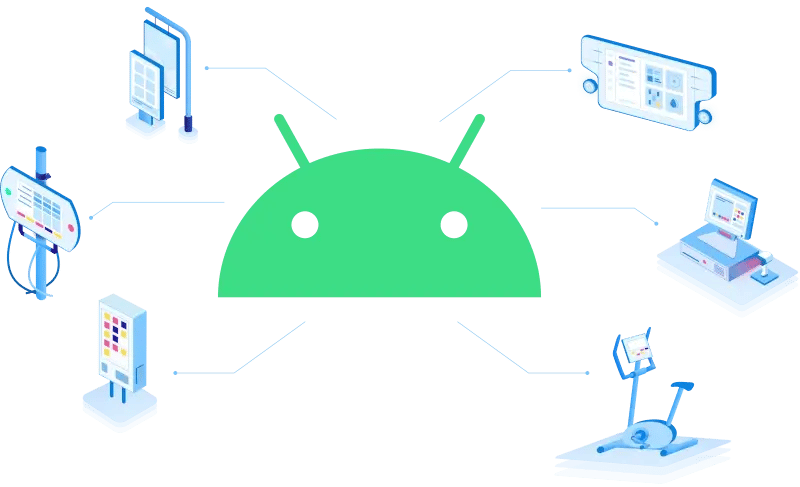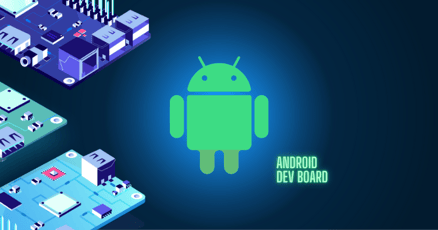This glossary provides definitions for the terminology and abbreviations commonly used in the world of Android OS and application development.
A
A set of Android functionality that allows developers to access hardware, sensors and other core functions of Android devices. Each API has a numerical level that corresponds to a specific Android platform version.
Android Debug Bridge (ADB)
A command-line tool that allows communication between a computer and an Android device. ADB can be used to install, uninstall and debug applications, transfer files and access the shell of the device. It is provided by Google as a part of Android SDK.
Android Interface Definition Language (AIDL)
A language used to define the interface between processes for the purpose of communication. It allows objects from different processes to interact with each other.
Android Neural Networks API (NNAPI)
An Android API designed to execute computationally intensive operations for machine learning on Android devices. This API serves as an intermediate layer between higher-level machine learning frameworks and hardware acceleration resources of the device.
Android Open Source Project (AOSP)
An open-source project created to guide the development of the Android platform, led by Google. AOSP gathered around itself a worldwide community of developers willing to contribute to and improve the source code of the Android operating system. Emteria’s deep expertise in AOSP audit and OS customization is key to the success of your new Android products.
Android Package (APK)
A file format used to distribute and install applications in Android OS. In fact, any APK file is similar to a JAR file with additional Android-specific files in a compressed ZIP format.
Android Runtime (ART)
An application runtime environment introduced in Android Lollipop. It is responsible for compiling Dalvik Executable (DEX) bytecode into device-specific machine code which can be executed by the CPU. ART is optimized to run multiple virtual machines on low-memory devices.
Android SDK (Software Development Kit)
A universal set of tools, libraries and documentation that developers use to design, build, test, and debug Android applications. Android SDK can be downloaded here.
Android Verified Boot (AVB)
A feature that ensures the integrity and security of Android devices. AVB safeguards the system boot process to protect the device against malicious attacks, modifications, and vulnerabilities.
Android Virtual Device (AVD)
A virtual machine that contains the full Android software stack and serves as a software representation of a physical device.
Android Virtualization Framework (AVF)
Android feature that was introduced in Android 13 in 2022 for the purpose of creating safe environments to compile and execute security-sensitive code. It provides an efficient way to configure and launch protected virtual machines.
Application Binary Interface (ABI)
A standard that defines how different components of binary programs interact on different hardware platforms. In Android each CPU architecture (e.g. arm, arm64, x86 or x86_64) has its own Application Binary Interface.
B
Technology specification for short-range wireless connection using low-cost transceiver chips that can be integrated into any mobile devices.
Bluetooth Low Energy (BLE)
A wireless communication standard designed for significantly lower power consumption compared to classic Bluetooth. A single coin cell battery can keep BLE supported devices in operation for months or even years.
Board Support Package (BSP)
A source code package of the bootloader, device drivers, Linux kernel and Android framework to build the whole Android OS and ensure that it can boot on a specific piece of hardware. Emteria offers the technology and services that can help manage, customize and long-term support different Android BSPs.
C
A set of Linux kernel interfaces required to run the Android Open Source Project.
Compatibility Test Suite (CTS)
A collection of more than two million test cases provided by Google to help manufacturers ensure their Android devices meet the Android compatibility requirements. Emteria provides effective tools to simplify testing and validation processes. See also Vendor Test Suite (VTS).
Cyber Resilience Act (CRA)
The EU regulation that obliges manufacturers to guarantee the digital security for all connected products offered on the EU market throughout their entire lifecycle until the end of the support period by providing OS security updates. Emteria offers services for security and updatability monitoring along with long-term support to ensure regulatory compliance with CRA.
D
A file format used by Android to encode compiled Dalvik bytecode that is executed by Dalvik virtual machines.
F
An encryption mechanism that allows different files to be encrypted with different keys that can be unlocked independently. See also Full Disk Encryption (FDE).
Firebase Cloud Messaging (FCM)
A cross-platform cloud messaging service developed by Google. It allows developers to send messages and push notifications to the following platforms: iOS, Android, Web, C++ and Unity. Also known as Google Cloud Messaging (GCM).
Full Disk Encryption (FDE)
An encryption mechanism that allows all user data on an Android device to be encrypted in order to prevent unauthorized access. Important: support for Full Disk Encryption was discontinued starting with Android 10 and newer. See also File-Based Encryption (FBE).
G
Universal pins on microprocessors or microcontrollers that can be dynamically configured as input pins for receiving signals or as output pins for controlling external components.
Generic Kernel Image (GKI)
A prebuilt kernel image that is suitable for all Android devices. Device-specific customizations are kept separately in vendor modules, thus allowing for independent and easier Linux kernel updates.
Generic System Image (GSI)
A device-independent implementation of Android system partition. It was introduced in Android Oreo in 2017 with the intention to separate device-specific code from Android-specific code.
Google Mobile Services (GMS)
A collection of applications and application programming interfaces (APIs) developed by Google for manufacturers of Android devices. Usually it is preinstalled by manufacturers on certified devices offering a unified user experience. Examples: Chrome, YouTube, Play Store, Google Drive, Gmail.
H
A software layer that bridges data exchange between low-level hardware components and high-level OS services. In Android it offers a standardized interface for hardware manufacturers to simplify lower-level driver updates implementation.
Human Machine Interface (HMI)
A software or hardware component like a mouse or a touchscreen that enables interaction of users with a device, system or machine.
I
The global network of physical devices, vehicles, appliances, and other physical endpoints that are embedded with sensors, actuators, software, and network connectivity for the purpose of collecting and exchanging data over the Internet.
J
Java Development Kit (JDK)
A software development environment that includes tools and libraries for Java developers.
L
Long-Term Support (LTS)
A practice of providing ongoing support and maintenance for a software product or system for an extended period of time. Emteria provides an end-to-end set of services for long-term Android support and OS security updates.
M
Mobile Device Management (MDM)
A software component that allows for inventory and administration of mobile devices, such as smartphones and tablets. Usually it is used for provision, configuration, and management of mobile devices remotely. Emteria offers a flexible MDM solution for a wide range of products and use cases.
N
Native Development Kit (NDK)
A set of tools that allows developers to use native code such as C and C++ in Android applications.
Near-field Communication (NFC)
A short-range wireless technology that enables mobile devices to communicate with each other without using other networks.
O
Original Device Manufacturer (ODM)
A company that designs and manufactures products according to the specifications provided by another company or client. Emteria works with many large ODMs to maintain and keep their Android BSPs secure and customizable.
Original Equipment Manufacturer (OEM)
A company that manufactures components or equipment other companies incorporate into their final products.
Over-The-Air updates (OTA)
A method of delivering updated software or firmware packages to remote devices (wired or wireless). Emteria offers a large set of services to implement OTA support in Android devices, create security updates and distribute update packages remotely.
P
Point of Sale (PoS)
A system that allows customers to make payments for goods or services. Examples: payment register, self-payment kiosk.
R
Radio Interface Layer (RIL)
An abstraction layer that enables communication between Android phone framework and radio hardware. It is a part of Hardware Abstraction Layer (HAL).
Raspberry Pi (RPi)
A series of low-cost single-board computers (SBC) made by the Raspberry Pi Foundation. Raspberry Pi provides a set of GPIO pins that can be used to control electronic components and connect to the Internet of Things (IoT). Emteria offers Android for Raspberry Pi 3 through Raspberry Pi 5 in the official Raspberry Pi Imager.
S
A network protocol for secure data exchange between two devices over the network. The client can access the remote server using public-key and private-key or password. Emteria provides Android images with integrated SSH-server.
Security-Enhanced Linux (SELinux)
A security architecture that enables system administrators to restrict access to programs and services, files, and network resources through mandatory access control (MAC) policies. Emteria provides comprehensive security services to enable SELinux and safeguard customized operating systems against modern threats.
Self Checkout (SCO)
A retail technology or hardware that enables customers to scan, pack and pay for their goods in a store by themselves without assistance of a cashier.
Single Board Computer (SBC)
A compact computer with processor, memory, storage, input/output ports and other features integrated onto a printed circuit board (PCB). Emteria supports different SBCs, including Rock (https://rockpi.org/) and Raspberry Pi (https://www.raspberrypi.com/).
System on Chip (SoC)
An integrated circuit with all essential components, including processor, memory, and communication interfaces, embedded in a single chip. Such design enables high computing performance, fast memory access, low power consumption and allows for more compact device design. Example: https://www.nxp.com/products/processors-and-microcontrollers/arm-processors/i-mx-applications-processors/i-mx-8-applications-processors
System on Module (SoM)
A fully-integrated circuit board with embedded processor, memory and communication interfaces. In order to be operated SoM has to be attached to a mainboard. Example: https://www.variscite.com/products/system-on-module-som
T
Trusted Execution Environment (TEE)
A protected environment provided by additional hardware feature within the main processor. It is designed to run isolated code to prevent unauthorized access. This isolation ensures sensitive tasks and data remain secure during execution, even if the main operating system gets compromised.
U
Universal Serial Bus (USB)
A serial-interface standard for telephony and multimedia connections to computer systems.
USB On-The-Go (OTG)
A specification that enables direct communication of portable USB devices without the need for a host computer.
V
A set of shared libraries vendors can use to implement HALs.
Vendor Test Suite (VTS)
Software components that Google provides to OEMs, vendors, and manufacturers to test the vendor-system interfaces implemented in the OEM’s vendor image and Linux kernel. By focusing on the Vendor Interface (VINTF), Android VTS ensures compatibility and functionality of hardware components and vendor-specific customizations with Android. Emteria provides effective tools to simplify testing and validation processes. See also Compatibility Test Suite (CTS).
Virtual Network Computing (VNC)
A technology for remote desktop sharing based on the Remote Frame Buffer (RFB) protocol. It provides a simple way to take control of a remote computer from any computer or mobile device over the Internet.
W
Wireless Fidelity (Wi-Fi)
A trademarked term for the IEEE 802.11x standard which refers to a family of wireless networking standards that enable electronic devices to exchange data or connect to the Internet using radio waves.
Build unique products, boost device performance
See why emteria is the chosen Android™ customization & management platform for OEM solution builders — and what it can do for your team and customers.




.png?height=230&name=blog-header(52).png)

